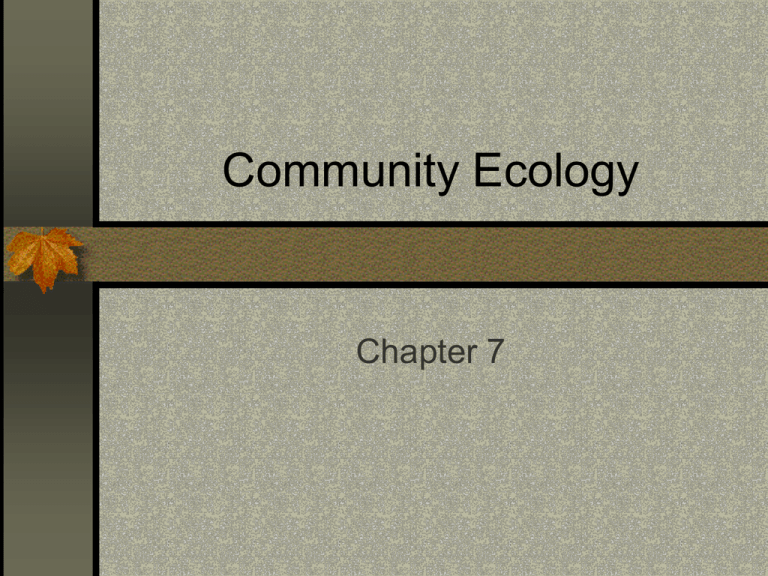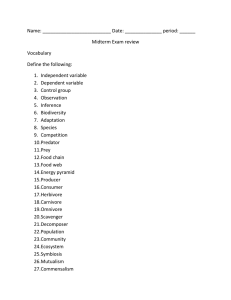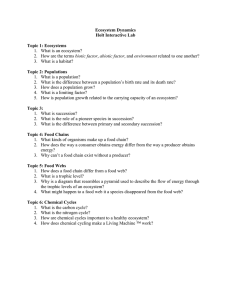Community Ecology Chapter 7
advertisement

Community Ecology Chapter 7 The flying fox Keystone species in tropical rainforest Pollinates plants while drinking nectar Spreads seed of fruit eaten Mutualistic relationship with durian fruit Help regenerate open areas through seed dispersal (80-90% new seed) Decline in numbers from deforestation and hunting Dispersal of diversity Groups are arranged either in clumps (most common), uniformly, or randomly Edge effects are ecotones where different species may live. Usually different microclimate than adjoining areas Largest Biodiversity Tropical rainforest Coral reefs Deep sea Tropical lakes Also considered species rich Tropical dry habitats Temperate shrublands (chaparral) Biodiversity continued Most diversity near equator Higher availability of resources Less evolutionary time High diversity leads to higher diversity More pressure from disease and parasites Speciation higher than background extinction Diversity in marine systems Higher diversity near 2000 meters and on bottom More stable away from surface Lack of nutrients below 2000m Abundant nutrient on bottom and variation of habitats Pollution lowers diversity (never would have guessed that) Diversity on Islands The bigger the more diverse The farther from mainland the less diverse Nonnative species Also called alien, exotic and introduced Generally have no natural predators so population goes unchecked, seriously damaging the ecosystem Often introduced by accident Cargo from foreign areas Pets and house plants that “escape” “Natural” migration due to climate changes Prime players Indicator species – serves as an early warning that an ecosystem is declining Birds – low birth rates, thin shells, birth defects Keystone species – a species that contributes greatly to an ecosystem even though they may not dominate in numbers Seed dispersal/pollination (birds) Habitat modification (beaver) Efficient recycling of matter Species interaction Intraspecific competition – competing with your own species Interspecific competition – competing with another species Compete over food, shelter, space, breeding, etc. Dibs, I saw it first! Interference competition – when two or more species try to limit access to a resource (some humming birds defend particular trees) Exploitation competition – when one group uses a resource faster than another (can lead to competitive exclusion principle (one dies out)) How to avoid competition Resource partitioning – using a limited resource at different times, in different places or different ways Think about how similar all birds are, but through evolution have developed different feeding patterns (beaks) Black skimmer seizes small fish at water surface Flamingo feeds on minute organisms in mud Brown pelican dives for fish, which it locates from the air Scaup and other diving ducks feed on mollusks, crustaceans, and aquatic vegetation Avocet sweeps bill through mud and surface water in search of small crustaceans, insects, and seeds Louisiana heron wades into water to seize small fish Dowitcher probes deeply into mud in search of snails, marine worms, and small crustaceans Oystercatcher feeds on clams, mussels, and other shellfish into which it pries its narrow beak Herring gull is a tireless scarialavenger Ruddy turnstone searches under shells and pebbles for small invertebrates Knot (a sandpiper) picks up worms and small crustaceans left by receding tide Piping plover feeds on insects and tiny crustaceans on sandy beaches Fig. 8.9, p. 182 Predator-Prey relationship Needed to keep gene pool strong Slow, sick, less agile, etc. “weak” are more easily caught, and are therefore removed from the gene pool. This strengthens the remaining population Symbiotic interactions 3 types of symbiosis – parasitism, mutualism, and commensalism Parasitism – one species (parasite) feeds on another organism (host) by living in or on the host. Parasites help promote biodiversity by controlling population size (eliminates the weak) Mutualism Two organisms (different species) interact and both benefit from the relationship Examples Clownfish/Anemones Tickbird/Rhinoceros Protozoan/Termites Fig. 8.13, p. 187 Commensalism Two species interact, one benefits and the other is unaffected. Some trees have mosses or epiphytes growing on them Fig. 8.14, p. 187 Succession Primary succession – takes place on new rock or lifeless ground Mosses/lichen begin to turn rock to soil Small fast growing plants take root (weeds) Larger plants grow in the nutrient enhanced soil Trees immigrate in from birds Mature ecosystem (forest) climax community Secondary succession Same as primary except in an area that once had life, but was ruined during a catastrophe (fire, flood, farming, etc.) Early Successional Species Midsuccessional Species Late Successional Species Wilderness Species Rabbit Quail Ringneck pheasant Dove Bobolink Pocket gopher Elk Moose Deer Ruffled grouse Snowshoe hare Bluebird Turkey Martin Hammond’s Flycatcher Gray squirrel Grizzly bear Wolf Caribou Bighorn sheep California condor Great horned owl Ecological succession Fig. 8.17, p. 190 Sustainability What maintains an ecosystem Inertia or persistence – ability of a system to resist disturbances Constancy – keep population level stable Resilience – ability to bounce back from a disturbance Thank you, have a nice day You are here!!



